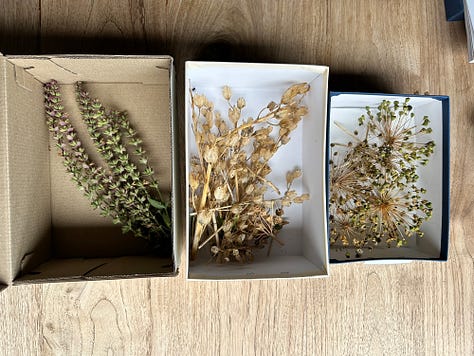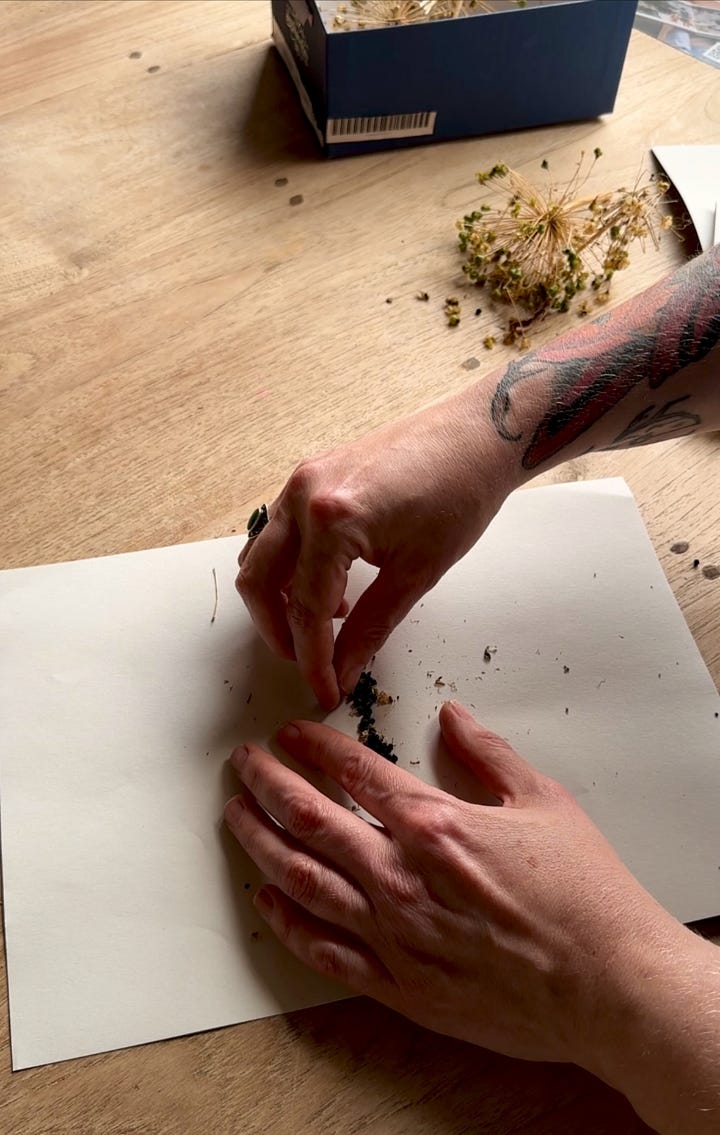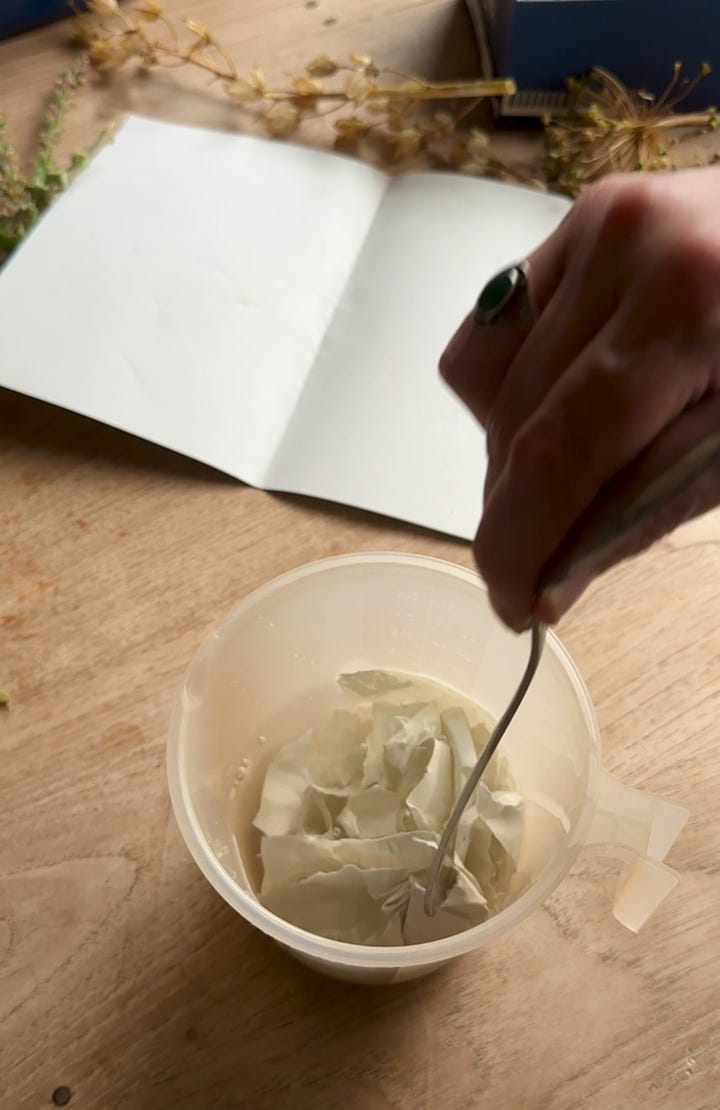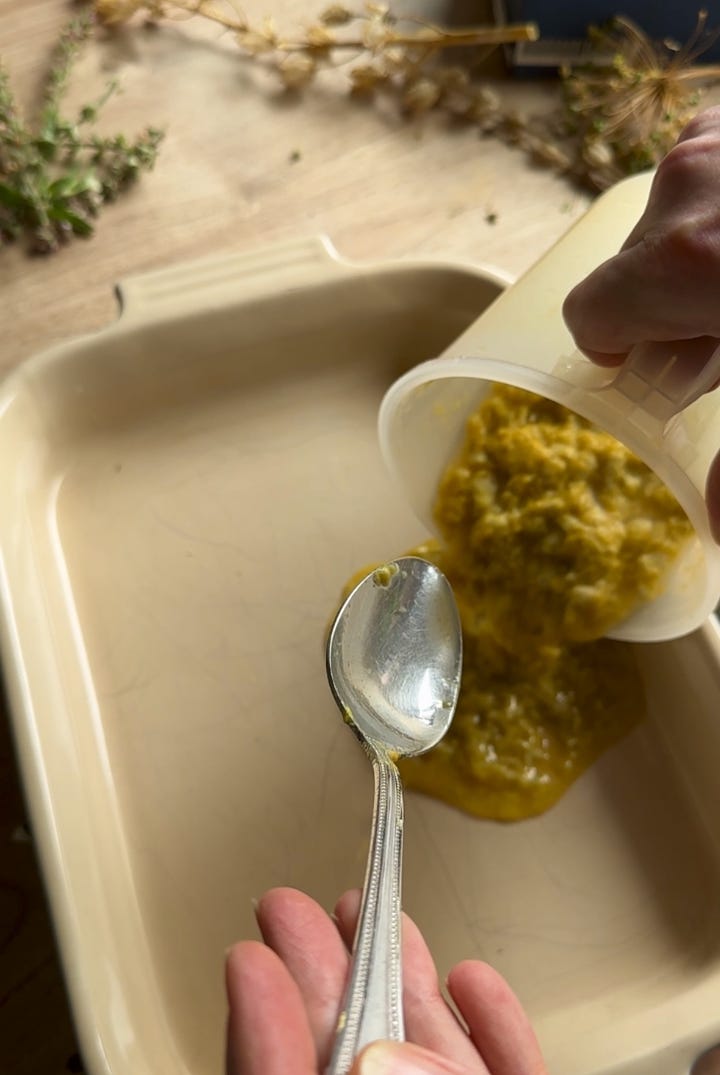Seasonal naturecraft: plantable seed paper (tutorial)
Why seed saving is great, and a papermaking tutorial video plus written instructions & an image gallery for clarification 🌾
Why seed saving is great, and a papermaking tutorial video plus written instructions & an image gallery for clarification.
When I walk my dog over lunch, sometimes I take pictures of shrubs in my neighbourhood that are full of bees and butterflies. Bumblebees love this one, for example, that I saw earlier today:
But what are you meant to do once all the things you’ve planted for the bees start to fade back and die?
For ages I thought that was it, to be honest.
This year I’ve gotten into houseplant propagation in a big way, and have duly found myself in the seed saving corner of the internet. Making plants from plants? For free? Yes please. Plants plants plants.
And so then, it being me, I was like HOW CAN I USE THESE IN USEFUL ART. So that’s where this email comes from. I was looking into what I can do with the seeds, aside from keeping them in an envelope and planting them.
What seed saving is
It’s a truth universally acknowledged that seed saving is fantastic, for a number of reasons.
Cost-savings aside (you don’t have to buy new plants!), it also helps towards maintaining biodiversity.
Why?
The Plant a Seed & See What Grows Foundation, in Why You Should Really Care About Seed Preservation, explain it better than I ever could:
In our times of climate change, seed preservation is crucial to help achieve genetic diversity that supports sustainable development and food security. Our current climate change realities from drought, flash floods, late and early frosts; hail storms to insect attacks on crops are distressing signs that we all have to do better now.
In a 2010 report from the UN Food and Agriculture Organization, it estimates that 75% of crop biodiversity has been lost from the fields from 1900 to 2000. In Canada, we only rely on four plant species: 1) wheat, 2) maize, 3) rice, and 4) potato. This leaves Canada’s agricultural and food systems very vulnerable. Experts believe that only open pollinated, heirloom seeds have the capability to adapt to these changing climate conditions. Due to their genetics, open pollinated, heirloom seeds are often resistant to local pests, diseases and extreme weather conditions.
Therefore, seed preservation of open pollinated, heirloom seeds promotes genetic biodiversity. With a broad pool of genetic variations, there will always be species that will survive and flourish, which consequently helps ensure food biodiversity.
Some seeds even carry cultural significance and history
By saving and sharing them, you become part of their story. For example, the floury Rush Queen potato is an endless source of delight in my family.
So I’m going to find ways to plant it here in Belgium and continue the story.
Each seed is a gift in our hands, given to us by the generations of farmers before us who held the ancestors of that seed. As modern seed keepers, we stand upon the shoulders of those farmers, and we must ensure future generations will know these seeds. Our gardens are the legacy of those farmers — their seed song. These seeds are our ancestors’ ecological knowledge that we’re tasked with holding at this moment in time. - Saving Culturally Significant Seeds
I made plantable paper full of seeds I saved and here is how I did it:
Here’s a video plus written instructions & an image gallery for clarification. I didn’t like that I used bits of new blank paper to make new paper. The paper making kit I bought came with just that.
That doesn’t really count as paper making, surely? Like, yeah alright, if you want to turn your junk mail into something useful, sure, use it, but aside from that I wouldn’t see it as true papermaking.
You can use old art, old kids’ scribbles, shopping lists, magazines, receipts, bus tickets, fruit peel, egg cartons, cardboard, etc. Check this out too (seaweed!): 7 things that can be used to make paper (and which aren’t trees)







Written instructions
Step one: saved seeds from allium & salvia plants in my garden. Tipped them onto paper and left them to dry out a bit.
Step two: made paper pulp out of newspaper and junk mail (sadly I don’t have any Vlaams Belang election material to use). I did this by hand, and I’d recommend using a blender instead as my finished paper turned out quite lumpy.
Step three: mixed turmeric into water to make a kind of natural food colouring.
Step four: poured the pulp concentrate into a big baking dish and added warm water. Stirred in the seeds. I added bits of lavender too because I had it to hand.
Step five: took my deckle thing and swished it around and around in the water until I achieved an acceptable cohesion and consistency. I bought mine on a whim ages ago, but you can just as easily make it one yourself with some window flyscreen and a frame. See instructions here.
Step six: laid the finished page on a big piece of felt & left to dry overnight.
Things I’d do differently:
Make the paper pulp in a blender instead of by hand to achieve a smooth pasty pulp.
I made the page on the wrong side of the frame the first time and had it all filmed and had to do it all again.
I don’t know about the turmeric. Maybe less next time. I’d like a pink or peachy colour.
Stamp the paper and turn it into little coasters or patches.
Thanks for reading
See you next week! I always love to hear from you in a comment, with a ❤️, or even a restack to Substack Notes. 🐝
Jessica






This is so delightful! I love thinking about those who held the seeds that came before now; that there is a rich history. Thank you for this!